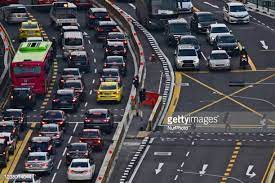OP ED – OPINION | ACADEMIA – Why Singapore isn’t gridlocked
Passengers are seen inside a crowded metro train in Singapore in this undated photo. (Shutterstock/joyfull)
.
 As cities around the world return to life after the COVID-19 pandemic, one thing may be missed: the near absence of traffic jams during the pandemic years.
As cities around the world return to life after the COVID-19 pandemic, one thing may be missed: the near absence of traffic jams during the pandemic years.
Traffic congestion is costly.
In 2016, motorists in the EU were estimated to have lost time worth €196 billion sitting in traffic.
But we could have the benefits of free-flowing roads while still allowing people to travel freely if we took a more efficient approach to managing traffic congestion.
.
Charging motorists who choose to drive during peak hours encourages them to drive during less crowded periods, carpool, or take public transport.
It can sustainably solve traffic problems, unlike building more roads, which often just attracts new traffic.
And, congestion charging is not a thought experiment: it has been implemented successfully in more than half a dozen major cities worldwide.
Singapore was the first.
Since 1975, the small city-state of 5.6 million people has been charging peak-hour motorists tolls.
Singapore’s congestion charging system started with printed pay-and-display licenses for city-area traffic, and was upgraded to electronic tolling in 1998, and in the mid-2020s will transition to satellite-based tolling.
Despite passenger car ownership increasing from about 100,000 cars in 1965 to half a million in 2019, traffic speeds have remained remarkably consistent in Singapore.
This has been achieved by adjusting congestion charges to maintain maximum peak hour traffic flows on Singapore’s expressways and in the city.
Policymakers may hesitate to consider congestion charges because of opposition from motorists and residents.
Only a handful of cities have implemented congestion charges.
However, these cities also hold lessons for how to persuade the public to accept congestion charge reforms.
In London, congestion charge revenues were largely earmarked for improving public transport, providing residents with alternatives to driving.
In Stockholm, a six-month trial resulted in substantial reductions in traffic congestion and growing public acceptance of the congestion charge.
In Singapore, the introduction of a congestion charge in 1975 was combined with a comprehensive park-and-ride system to encourage carpooling and public transport use.
To address congestion outside the central city, Singapore started restricting car growth in 1990 through a vehicle quota system, which resulted in high car prices.
This created a new concern — that the middle class was being priced out of car ownership.
The introduction of Electronic Road Pricing in 1998 was thus accompanied by promises that restrictions on car ownership could be relaxed if expanded congestion charging successfully managed traffic snarls. ]
Singapore today focuses on a ‘car-lite’ strategy of improving public transport to reduce the need to own and use a car as much as possible. ]
The experience from cities as diverse as London, Singapore and Stockholm shows policymakers can persuade the public to accept congestion charging through a combination of promoting the benefits of reduced congestion, using revenues to improve public transport and roads, and adjusting other motoring policies to manage motorists’ concerns.
Congestion in cities will only get worse, especially in rapidly growing parts of the world.
Congestion charging can be both a politically acceptable and economically efficient solution, reducing traffic congestion while providing the funds to improve public transport and urban liveability.

The writer is associate professor of economics, School of Business, Singapore University of Social Sciences; and Adjunct Senior Research Fellow, Asia Competitiveness Institute, Lee Kuan Yew School of Public Policy. Originally published under Creative Commons by 360info™.
.
Walter Theseira (360info)
Singapore
● Fri, February 17, 2023










